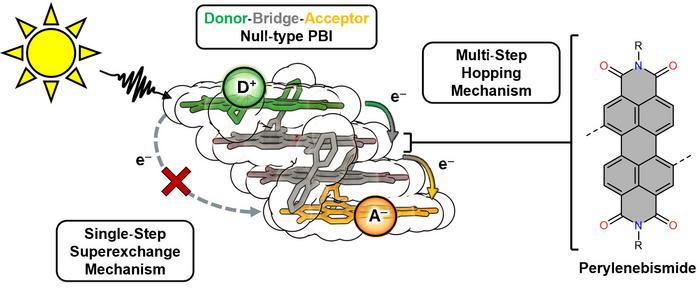
In the search for innovative solutions to environmental challenges, artificial photosynthesis stands out as a promising frontier. This technology aims to emulate the natural process through which plants convert light energy into chemical energy, with the potential to produce sustainable fuels while mitigating carbon dioxide levels in the atmosphere. Recent breakthroughs led by a distinguished group of researchers at Julius-Maximilians-Universität (JMU) Würzburg in Germany signal significant progress in this field, demonstrating how intricately complex systems can harness light for energy beyond traditional methods.
Photosynthesis, the remarkable biological process that powers life on Earth, involves a meticulously coordinated interplay of molecular components, including pigments, proteins, and various other molecules. The challenge of replicating such a multifaceted system artificially lies in understanding how energy is absorbed and transferred at the molecular level. The recent research conducted by Professor Frank Würthner’s team, along with collaborators from Yonsei University in South Korea, has taken a crucial step by successfully mimicking part of this intricate mechanism.
The team’s work culminated in the development of an advanced stack of artificially synthesized dyes, designed to mirror the photosynthetic apparatus found in plant cells. Central to their innovation is a new arrangement of four stacked dye molecules, closely resembling the natural transport of energy that drives photosynthesis. This configuration allows for the efficient absorption of light energy at one end of the structure, which is then converted into charge separation before being transferred in a stepwise manner towards the opposite end.
Understanding the underlying principles of charge transport is vital in this field. With their novel dye stack, the researchers can control the charge transport process using specific light triggers. This ability not only enhances the speed of electron transport, which is critical for any practical applications, but also significantly increases the efficiency of the overall energy conversion process. Dr. Leander Ernst, a PhD student who played a pivotal role in synthesizing the stacked structure, emphasizes the importance of these advancements for the future of artificial photosynthesis.
This groundbreaking research is not simply an academic exercise; it holds the potential for real-world applications. As the global community grapples with climate change and the quest for sustainable energy alternatives, replicating the efficiency of natural photosynthesis could lead to novel energy solutions. By effectively capturing and converting solar energy, this technology could significantly reduce our reliance on fossil fuels, paving the way for cleaner, renewable energy production.
The path forward for the JMU research team includes ambitious plans to expand their system beyond a stack of four dye molecules. Their objective is to develop a more complex nanosystem that can function like a supramolecular wire. Such wires would be capable of extending the distance over which light energy can be absorbed and transported, further enhancing the efficiency of energy transfer. This ambitious goal reflects the team’s commitment to advancing the field of artificial photosynthesis substantially.
The implications of this research extend well beyond laboratory walls. If successfully scaled up, these innovations could form the basis of new materials with significant utility in the energy sector. Concepts such as artificial leaves, which efficiently convert sunlight into fuel, could become a reality, fundamentally transforming how we approach energy generation and carbon capture.
The scholarly impact of this research is underlined by its publication in the prestigious journal Nature Chemistry, ensuring that the findings reach a wide audience within the scientific community. Sharing knowledge through such outlets fosters collaboration and encourages others in the field to build upon established discoveries, accelerating the pace of innovation.
The full experimental study detailing these findings provides valuable insights into the methodologies used to create and analyze the dye stack, as well as the specific technical challenges addressed. It shines a light on the importance of experimental rigor in validating the efficacy of such complex systems, ensuring that promising concepts can transition from theoretical frameworks to practical applications.
In conclusion, the strides made by Professor Würthner’s team in simulating fundamental aspects of photosynthesis are both remarkable and timely. The combination of scientific curiosity, technological innovation, and collaborative efforts positions artificial photosynthesis as a key player in the ongoing quest for sustainable energy solutions. The world eagerly watches as these ideas develop, holding promise for a cleaner, greener future where the principles of nature inform and inspire human ingenuity.
The exploration of artificial photosynthesis mirrors humanity’s broader quest for sustainable solutions to pressing environmental challenges. As researchers continue to deepen their understanding of photosynthetic processes, we can expect further innovations to emerge, each one bringing us closer to harnessing nature’s own strategies in service of humankind.
Subject of Research: Artificial Photosynthesis
Article Title: Photoinduced stepwise charge hopping in π-stacked perylene bisimide donor-bridge-acceptor arrays.
News Publication Date: 14-Mar-2025
Web References: http://dx.doi.org/10.1038/s41557-025-01770-7
References: Nature Chemistry
Image Credits: Leander Ernst / University of Wuerzburg
Keywords
Artificial photosynthesis, energy transport, molecular science, sustainable energy, dye synthesis, carbon dioxide reduction
Tags: advancements in renewable energy researchartificial photosynthesis technologycarbon dioxide reduction methodsenvironmental challenges and solutionsinnovative energy conversion techniquesinterdisciplinary research in energyJMU Würzburg research breakthroughslight energy to chemical energy conversionmimicking natural photosynthesis processesmolecular systems for energy harvestingphotosynthetic dye moleculessustainable energy solutions





